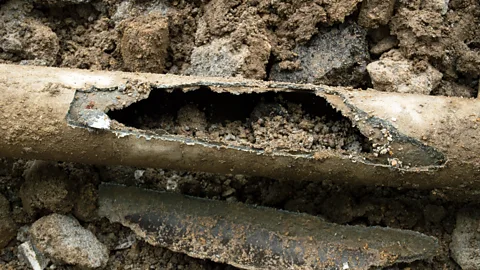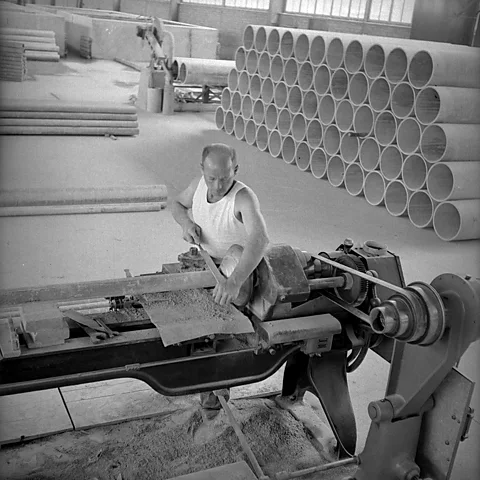Asbestos in drinking water: What does it mean for human health?
 Getty Images
Getty ImagesHundreds of thousands of miles of pipes made from asbestos cement deliver drinking water to people around the world, but are reaching the end of their lifespan and starting to degrade. Scientists are now debating whether this could pose a risk to human health.
"The water pipe burst on the top of the hill and flooded into the gas network," remembers Alan Walker, owner of the Village Stores in Stannington, a suburb of Sheffield on the edge of the Peak District in England. "By the morning, people were turning on their gas hobs and water was coming out. It was one of the worst winters we had. We were one of the last houses to be reconnected, 13 days later."
He is recalling an incident from December 2022. The burst water main affected more than 3,000 homes, and around 10,000 people in Stannington. More than a year on, it should be just a bad memory of a cold and unpleasant winter. But the water burst highlighted another nagging concern.
"At the time we were cold and tired, and very frustrated," says Penny Baker, a local councillor for the area. "Everybody's mind was focused on heat, food, and vulnerable people. It was only later that we started to think, is there a concern?"
The pipe that burst was constructed from a mix of asbestos and cement, known as AC piping. To create the material, asbestos is mixed into cement to improve its tensile strength when under stress, for instance when being stretched or pulled, as well as preventing corrosion. These type of pipes have been installed across the world since the early 1900s. Although many water authorities have stopped installing them, existing asbestos cement piping is regarded to have a lifespan of 50-70 years and water is still supplied through these pipes in many areas.
By 1988, 23,000 miles (37,000km) of asbestos cement piping had been installed in the UK, delivering water to 12 million people. Depending on where you look in the country, they still account for up to 27% of water pipes in the UK (the BBC obtained figures from all water companies in the UK). There are also more than 630,000 miles (1.01 million km) of asbestos cement pipe buried across the US, according to the Environmental Protection Agency. Many communities in Canada still have their water supplied through asbestos cement pipes and Australia has 25,000 miles (40,000km) of water mains pipes made from the material.
There are growing concerns that as these ageing pipes near the end of their expected lifespan they will deteriorate, leading to more breakages. But even before that stage, after decades of water running through them, the walls of the pipes can soften due to calcium from the cement leaching out, leading to corrosion. According to one study of 50-year-old pipes in Slovenia, this allows asbestos fibres to be released into the water.
This risk of water contamination is a concern for scientists and public health campaign groups. Although asbestos can enter water supplies from natural sources in areas where it is found, these degrading pipes are emerging as another source of exposure, leading to questions about the impact this may have on human health.
The evidence is mixed as best.
 Katharine Quarmby
Katharine Quarmby"My concern is that it is in drinking water," says Arthur Frank, professor of public health and professor of medicine at Drexel University in Philadelphia. He is one of the leading international experts on asbestos and has been sounding the alarm about ingestion as a possible mechanism for asbestos-related conditions. "The risk may not be great. But it is generally accepted that there is no safe level of exposure to asbestos."
Asbestos is a known carcinogen to humans, meaning it is capable of causing cancer. When asbestos fibres become airborne and are inhaled, they are known to lodge in the lungs and other parts of the airways, where they can cause scarring, inflammation, asbestosis – an inflammatory condition leading to permanent lung damage – and cell damage that lead to cancers, including mesothelioma, an incurable cancer of the lining that covers organs such as the lungs. For decades, however, the risk from swallowing asbestos has been thought of as small as most fibres were assumed to pass through the gut and be expelled in faeces.
Currently, the World Health Organisation (WHO) does not consider ingestion of asbestos in drinking water to be a serious risk to human health. The evidence is contradictory, with some epidemiological studies showing a correlation between asbestos exposure through drinking water and incidences of stomach and gut cancers. But others have failed to find such a link, and animal studies have also not provided definitive evidence that it can lead to cancers in the gastrointestinal tract.
This has not stopped some countries from adopting a precautionary approach to asbestos in drinking water. The US Environmental Protection Agency (EPA) has had a maximum safety limit of seven million fibres per litre in place since 1974, but this only applies for asbestos fibres longer than 10 micrometres. Longer fibres have been shown to cause the majority of asbestos-related respiratory disease, while the risk from shorter fibres is thought to be low, although the Centres for Disease Control and Prevention still warns there is evidence that fibres as small as five micrometres can cause injury.
The average length of fibres in asbestos cement pipes in the US is just four micrometres, according to one study of water samples from the 1980s. A more recent study from New Zealand also found that mains water supplies in Christchurch had far higher concentrations of shorter fibres than those above 10 micrometres. And the fate of short asbestos fibres when ingested is still unclear.
There are some scientists, such as Frank, who argue it is time for more detailed research on the impact on human health. "The evidence is getting clearer and clearer,” Frank says. One scientific review published last year by Italian researchers highlighted that large numbers of asbestos fibres appear to accumulate in the colon. Other studies have shown links between high levels of industrial asbestos exposure and incidents of colorectal cancer, although often there could be other causes at work, such as exposure to different toxic chemicals or smoking and alcohol use.
There are also tentative concerns that asbestos can migrate from water into the air if high enough levels are reached in turbulent running water.
One place where there is an ongoing and emerging debate about the possible carcinogenic risk from asbestos exposure through ingestion is in Italy. A 2019 Italian research paper looking at potential hazards suggested that a precautionary approach should be adopted, given the "ongoing debate on the possible carcinogenic risk associated with asbestos exposure through ingestion".
This article is part of a cross-border investigation on asbestos in water pipes, which is made in a collaboration between Investigative Reporting Denmark, IRPIMedia in Italy, Oštro Slovenia and Oštro Croatia, Reporters Foundation in Poland, the BBC and TV2 Nord in Denmark. The investigation is supported by Journalismfund Europe.
Giovanni Brandi, an associate professor of medical oncology at the University of Bologna, has been studying the possibility that ingested asbestos fibres may be responsible for disease in the liver and bile ducts. He recently wrote about his concerns around drinking water as a "hidden source of asbestos exposure" in the public policy journal Open Access Government.
Another Italian scientist, Agostino Di Ciaula, a medical doctor and biomedical researcher at the Policlinico University Hospital of Bari, in southeast Italy, and president of the scientific committee for the campaign group, the International Society of Doctors for the Environment, believes the risk from the long-term consumption of drinking water containing asbestos has been underestimated to date. But he says "definitive and convincing studies aimed at the identification of a risk threshold are lacking".
"Thus, at the moment it is impossible to identify a 'safe' threshold of asbestos fibres in drinking water," says Di Ciaula. "Please consider that asbestos fibres contained in water can be also inhaled."
The WHO produces detailed drinking water quality guidelines every four years, with the next update due in 2026. It currently does not set an exposure limit, and most countries adhere to these guidelines.
The latest version of the WHO guidelines, published in 2022, however, calls for "investigative monitoring" to help determine the number, size and shape of fibres getting into water supplies from older asbestos cement water pipes. The guidelines note it was "appropriate to minimise the concentrations of asbestos fibres in drinking-water as far as practical".
An evaluation in 2012 by the International Agency for Research in Cancer (IARC), which is part of the WHO, stated that the concentration of asbestos fibres can be as high as 10-300 million per litre in some locations.
"The average person drinks about two litres of water per day," the report says. "Risk of exposure to asbestos in drinking-water may be especially high for small children who drink seven times more water per day per kg of body weight than the average adult."
But the WHO notes that the IARC working group was "evenly divided" about whether there was sufficient evidence that asbestos could cause colorectal cancer. A spokesman for the IARC told the BBC that it had no current plans to re-evaluate the issue of asbestos in drinking water.
 Getty Images
Getty ImagesIn the UK, the WHO drinking water guidelines are effectively replicated by the Drinking Water Inspectorate (DWI), which monitors the testing of drinking water by water companies. The DWI last examined the subject more than 20 years ago, with its report acknowledging: "Most waters [in the UK], whether or not distributed through asbestos cement pipes, contain asbestos fibres." Despite this, the DWI does not require water companies to monitor asbestos in water, and does not do so itself, which is says is in line with the WHO guidelines. In a statement, the DWI told the BBC: "Although there are still some cement lined asbestos mains in distribution networks, there is no research evidence we are aware of that indicates that asbestos is dangerous if ingested, only if it is inhaled."
Elsewhere in Europe there have been attempts to take a more cautious approach. In October 2021 the European Parliament adopted a resolution on asbestos, calling on member states to carry out regular monitoring for the material in drinking water while also taking preventive measures "in case there is a risk to human health". This was not included, however, in the final negotiations with the European Council and European Commission, and did not make it into the Asbestos Work Directive, which became law across the EU in 2023.
Some regions are adopting much stronger measures in case of harm. The state of Victoria, in Australia, which is home to 70% of the country's asbestos cement pipes that provide water to homes and businesses, is now replacing the pipes, leaving the old pipes buried in the soil, where they will eventually decompose. This is considered the safest option.
Repairing or removing asbestos cement pipes is classified as "high risk construction work". Using water industry data, the Australian Asbestos Safety and Eradication Agency (ASEA) estimated in their 2018 strategic review that many of the asbestos cement water and sewer pipes across the country are now reaching the end of their usable lifespan. This means they need replacing or realigned, or maintenance work – which could cost around Aus $9.5bn (£4.9bn/$6.2bn) over the next 50 years.
The ASEA released guidelines on how to manage asbestos cement water and sewer pipes in 2021. Any tools or equipment can only be used if they are enclosed or used in a way that captures the fibres to prevent them becoming airborne. Air monitoring may be required and the work area, tools – and workers – must be decontaminated immediately afterwards.
In Canada, a campaign is gathering pace to address public concerns about water piping and increased numbers of bursts. Julian Branch, a former journalist turned asbestos campaigner, lives in the city of Regina, where there are 370 miles (600km) of asbestos cement water piping – equivalent to two thirds of the city's mains water pipes.
"A lot of people are calling for the precautionary principle to be applied in the case of ingested asbestos," says Branch. "I would say there has never been a stronger case for the principle to be applied. But the WHO says, it's OK to drink water that may contain asbestos."
A spokesperson for the WHO referred the BBC to its latest guidance on asbestos in drinking water, and added: "Although the data on adverse effects following ingestion are less clear, the overall weight of evidence from available epidemiology and animal studies does not suggest an increased risk of cancer following ingestion of asbestos in drinking-water.
"However, in view of the uncertainties and limitations of the data," the spokesperson continued, "it is appropriate to minimise the concentrations of asbestos fibres in drinking-water as far as practical."
The topic has made national headlines in Canada in recent months after CTV News broadcast a documentary about asbestos in drinking water in 2023. Health Canada states that there is "no consistent, convincing evidence" that asbestos ingested through water is harmful to human health. But the Green Party in Canada has tabled a petition from citizens, NGOs and others, asking the federal government to take urgent action on crumbling AC pipes. Party leader Elizabeth May told fellow parliamentarians that the topic was "understudied and unregulated".
In South Africa a non-profit organisation, the Helen Suzman Foundation, has been leading the disquiet about rapidly deteriorating asbestos water cement pipes across the country. In a briefing paper on the topic, it warns that ingested asbestos could lead to a "fourth wave" of exposure to the substance.
Yvonne Waterman, an asbestos liability legal expert who founded the European Asbestos Forum foundation to bring together asbestos experts, shares those fears. "Over the course of many years, I have seen the lists of both recognised and suspected asbestos-related disease grow gradually, as scientific understanding of them improves," she says. "The 'classic' asbestos diseases focus on the airways and lung. The 'new' asbestos diseases seem to follow the digestive route. The big question is, why?"
Back in Stannington, locals are awaiting final reports from the council, Yorkshire Water, and regulators on the impact of the water burst. No testing for fibres in the water is planned, Yorkshire Water has confirmed. Local Sheffield MP Olivia Blake tells the BBC that she has been approached by constituents asking her whether the water is safe to drink. "I have found it difficult to get a conclusive picture," she says.
Yorkshire Water, the company responsible for the area, told the BBC that customer safety is paramount. "We routinely repair pipes that are made from asbestos cement and have stringent processes in place for doing this to make sure we keep everyone safe," a spokesperson said, adding they wanted to reassure residents in Stannington that they followed "all processes and risk assessments when working with the burst pipe".
"When we did the initial repair, there was no airborne asbestos risk due to the clamp we used to repair the pipe and the measures we took to manage this."
A specialist team was brought in to remove the offending section of pipe about a month after the initial repair. Yorkshire Water added it does not routinely test for asbestos in water, in line with WHO guidelines.
In Stannington, local people fear another burst. Data from the water industry suggest that the conditions there – a system under pressure with a growing population, ageing pipes and soft water – can all be factors to increase that risk.
Stannington is is far from the only area at risk of future pipe failures, according to a 2020 report by UK Water Industry Research (UKWIR), a body which is supported by the water companies. Around 60% of the 31,000 miles (50,000km) of asbestos cement water pipes in the UK and Ireland were installed more than 50 years ago, meaning that many are reaching the age of failure. These figures were confirmed by requests to all water companies in the UK, which revealed some pipes are thought to be more than a century old. Most UK water companies report asbestos cement pipes being installed in the 1950s, 60s, and 70s.
The UKWIR's National Failure Database, which looks at when and how pipes fail, reveals that the highest rate of deterioration is in pipes installed after 1960. The report warns that burst rates for such pipes are increasing by 28% on average in each decade. Yet, it could cost between £5-8bn ($6-10bn) to replace the stock of asbestos cement water mains currently in use in the UK and Ireland.
The UKWIR says similar patterns of pipe failures can be found in Canada, New Zealand and Australia.
The Stannington residents' worry and uncertainty remains unabated. With the debate about asbestos and drinking water heating up around the world, they can only wait, and hope for reassurance.
* This is the first of a two part investigation. Part two – to be published in February 2024 – examines the growing global problem of asbestos waste.
--
If you liked this story, sign up for The Essential List newsletter – a handpicked selection of features, videos and can't-miss news delivered to your inbox every Friday.
